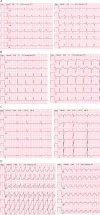Supraventricular Arrhythmias in Patients with Adult Congenital Heart Disease
- PMID: 28835834
- PMCID: PMC5517371
- DOI: 10.15420/aer.2016:29:3
Supraventricular Arrhythmias in Patients with Adult Congenital Heart Disease
Abstract
An increasing number of patients with congenital heart disease survive to adulthood; such prolonged survival is related to a rapid evolution of successful surgical repairs and modern diagnostic techniques. Despite these improvements, corrective atrial incisions performed at surgery still lead to subsequent myocardial scarring harbouring a potential substrate for macro-reentrant atrial tachycardia. Macroreentrant atrial tachycardias are the most common (75 %) type of supraventricular tachycardia (SVT) in patients with adult congenital heart disease (ACHD). Patients with ACHD, atrial tachycardias and impaired ventricular function - important risk factors for sudden cardiac death (SCD) - have a 2-9 % SCD risk per decade. Moreover, ACHD imposes certain considerations when choosing antiarrhythmic drugs from a safety aspect and also when considering catheter ablation procedures related to the inherent cardiac anatomical barriers and required expertise. Expert recommendations for physicians managing these patients are therefore mandatory. This review summarises current evidence-based developments in the field, focusing on advances in and general recommendations for the management of ACHD, including the recently published recommendations on management of SVT by the European Heart Rhythm Association.
Keywords: Congenital heart disease; accessory pathway; atrial flutter; atrial tachycardia; catheter ablation; sudden cardiac death; supraventricular tachycardia.
Conflict of interest statement
Disclosure: The authors have no conflicts of interest to declare.
Figures
References
-
- Love BA, Collins KK, Walsh EP, Triedman JK. Electroanatomic characterization of conduction barriers in sinus/atrially paced rhythm and association with intra-atrial reentrant tachycardia circuits following congenital heart disease surgery. J Cardiovasc Electrophysiol. 2001;12:17–25. - PubMed
LinkOut - more resources
Full Text Sources
Other Literature Sources





